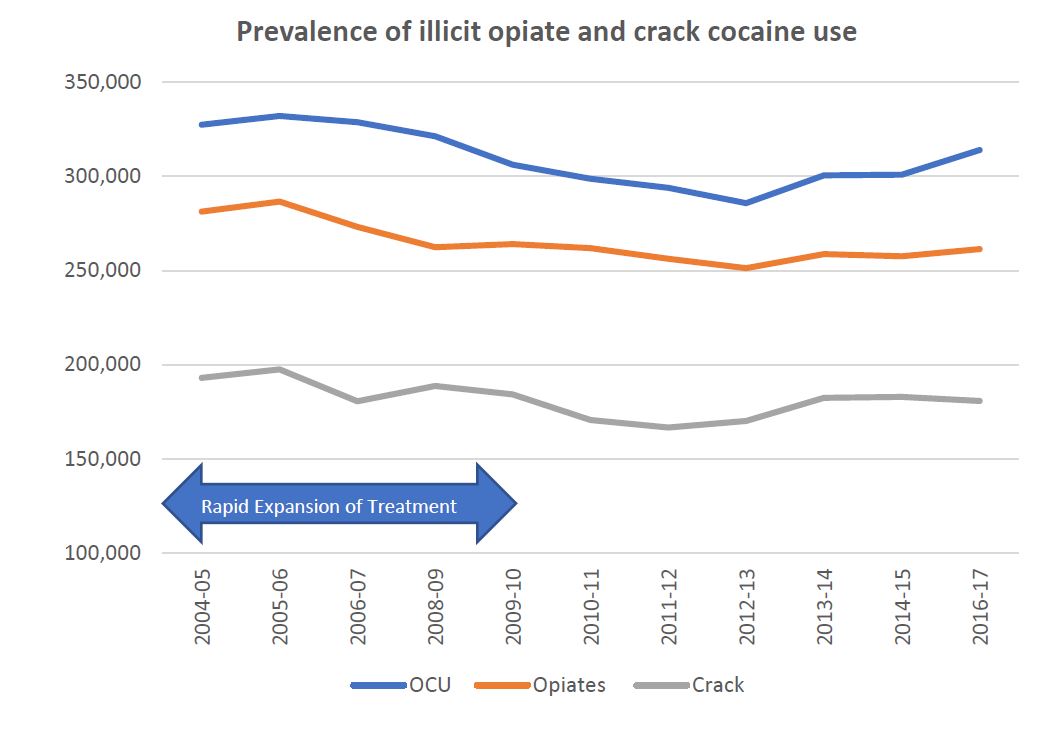Prevalence of problematic drug use
This is the sixth in a series of posts based on perhaps the most important drug-related report of the current century, Dame Carol Black’s Review of Drugs . Today’s post looks at the section from that report dedicated to the prevalence of problematic drug use.
The report looks at trends in the estimated number of opiates and/or crack cocaine users over the last 15 years. Dame Carol concludes that the rapid expansion of treatment during the 2000s help reduce the prevalence and incidence of opiate and crack cocaine use. However, by the estimated number of new crack users fell substantially between 2005 and 2012, it has increased again since that time, notably in people aged under 30.
However, the prevalence of illicit use has remained relatively stable during this time though there is a recent slight upward trend in use.
Highest rates in the North of England
The report also profiles the geographical variations in the use of heroin and/or crack, finding that the highest rates of use are in the north of the country.
The North West and North East now have the highest rates of illicit opiates and/or crack cocaine use, with the North East seeing a sustained increase in use over the last 15 years. Most other regions have seen falls in their rates during this time or they are at the same level as they were in 2004/5. Middlesbrough and Blackpool have the highest rates of heroin and crack use per population, being 2.5 times the national average (8.7 per 1,000).
Conversely, London saw substantial falls in the proportion of its residents using heroin and crack at the end of the last decade, with the rate levelling off since then.
Long term heroin use
While the North East and North West have very similar rates of opiate and/or crack use, many more users in the North West currently in treatment started their use pre-1990. The North East has the highest percentage of heroin users having started their use post 1990. London has a similar pattern of ‘year of first use’ as the North West with nearly a third of heroin users in treatment having started pre-1990. The 20 Local Authorities with the highest rates of long term heroin use are all in the North West and London.
However outcomes, mortality and morbidity is vastly different for heroin users between the two regions with the North West having much poorer rates of recovery and much higher rates of deaths.
The increase in crack
While London still has one of the highest rated crack use, it has fallen substantially over the last 10 years. However, other regions such as the East of England, the South East and the North East have seen significant increases since 2012. The increases in crack use in these areas are likely, at least in part, to be due to changes in patterns of distribution/quality – particularly the development of county lines drug dealing and the increases in availability and purity of cocaine.
Summary of prevalence
- The increases in opiate and crack users (OCUs) is likely to be driven by people using crack without opiates.
- The highest rates of OCU are seen in the north of the country and in the most deprived areas, this is also where the poorest treatment outcomes and highest harms are seen.
- The rates in the North vary in terms of when each of the regions was hit by the heroin epidemics of the 1980s and 90s. The North West has a much higher percentage of people starting heroin use in the 1980s and before, similar to London.
- The increases in crack use have been geographically widespread but particularly concentrated in the North East and also in less established urban areas.
- New crack drug markets are opening up in these areas driven by changes in distribution patterns and county lines.
- New crack use has been seen across all age groups, with more use of crack alongside opiates in older long time heroin users increasing their risk of mortality.
- Anecdotal evidence suggests that previous negative associations with crack are not seen in freebasing cocaine, with a risk that cocaine smoking then leads to cheaper and easier crack use.
- As most of the individual and societal harms and costs are associated with OCUs then any increases in prevalence will likely increase the level of drug related harms and costs.
- Further research is needed into why some, particularly younger and new, crack cocaine users do not access currently available treatment.







